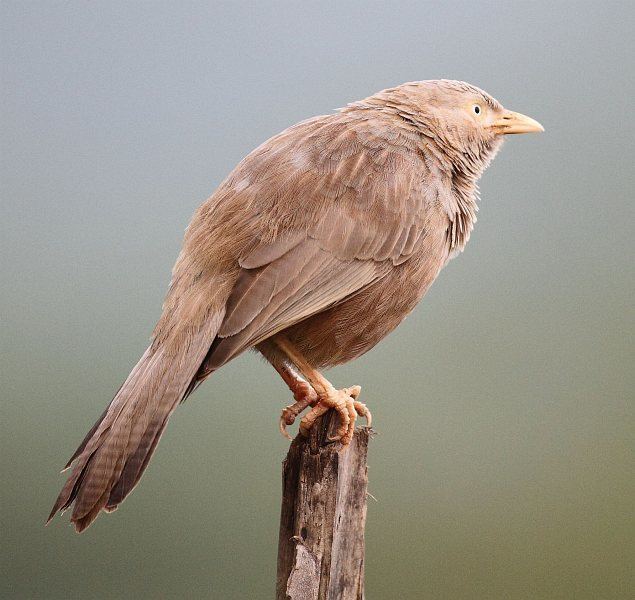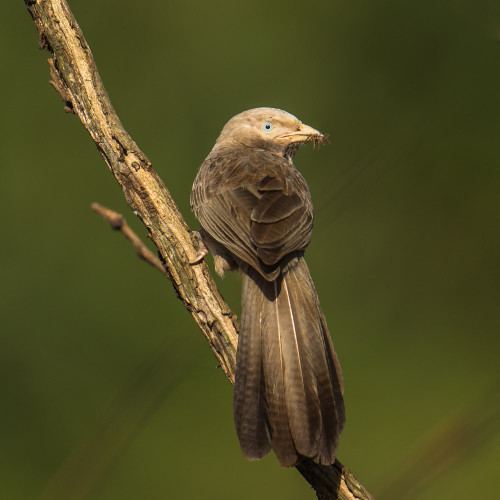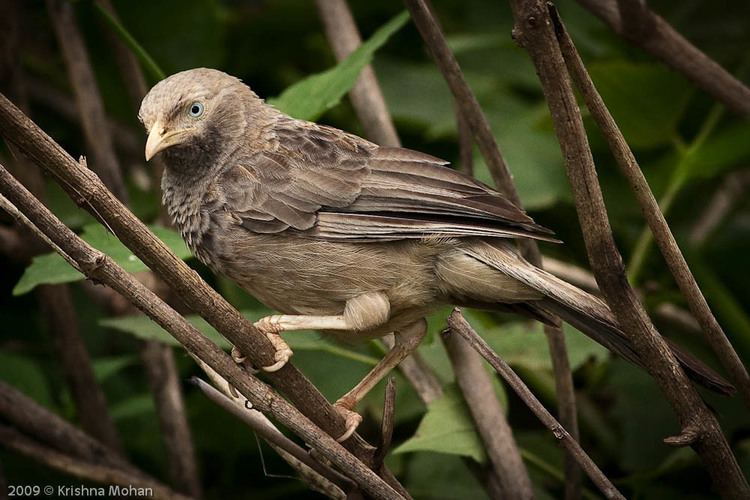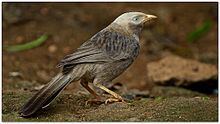Higher classification Turdoides | Family Leiothrichidae Scientific name Turdoides affinis Rank Species | |
 | ||
Similar Bird, Turdoides, Orange‑billed babbler, Jungle babbler, Rufous babbler | ||
Baby yellow billed babbler
The yellow-billed babbler or white-headed babbler (Turdoides affinis) is a member of the Leiothrichidae family endemic to southern India and Sri Lanka. The yellow-billed babbler is a common resident breeding bird in Sri Lanka and southern India. Its habitat is scrub, cultivation and garden land. This species, like most babblers, is not migratory, and has short rounded wings and a weak flight and is usually seen calling and foraging in groups. It is often mistaken for the jungle babbler, whose range overlaps in parts of southern India, although it has a distinctive call and tends to be found in more vegetated habitats. Its name is also confused with T. leucocephala, which is also known as white-headed babbler.
Contents
- Baby yellow billed babbler
- Yellow billed babbler turdoides affinis
- Description
- Distribution and habitat
- Behaviour and ecology
- Breeding
- Mortality
- In culture
- References

Yellow billed babbler turdoides affinis
Description

These birds have grey brown upperparts, grey throat and breast with some mottling, and a pale buff belly. The head and nape are grey. The Sri Lankan form T. a. taprobanus is drab pale grey. Nominate race of southern India has whitish crown and nape with a darker mantle. The rump is paler and the tail has a broad dark tip. Birds in the extreme south of India are very similar to the Sri Lankan subspecies with the colour of the crown and back being more grey. The eye is bluish white. The Indian form is more heavily streaked on the throat and breast. The Sri Lankan subspecies resembles the jungle babbler, Turdoides striatus, although that species does not occur on the island.

Seven distinctive vocalizations have been noted in this species and this species has a higher pitched call than the jungle babbler. The jungle babbler has calls that have a harsher and nasal quality.

The taxonomy of this species was confused in the past and confounded with the sympatric jungle babbler and the orange-billed babbler of Sri Lanka.
Distribution and habitat

This species is patchily distributed in southern India and Sri Lanka. The nominate subspecies is found in Andhra Pradesh, south of the Godavari river and Karnataka south of Belgaum into Tamil Nadu. It prefers lower altitudes and drier habitats than the jungle babbler but sometimes is found alongside it. The Sri Lankan subspecies is found in the lowlands and hills up to about 1500m avoiding heavy forest.
Behaviour and ecology

The yellow-billed babbler lives in flocks of seven to ten or more. It is a noisy bird, and the presence of a flock may generally be known at some distance by the continual chattering, squeaking and chirping produced by its members. One member often perches high and acts as a sentinel while the remaining members of the flock forage on or close to the ground. They feeds mainly on insects, but also eat fruit, nectar and human food scrap. They have been known to take Calotes versicolor lizard and whip-scorpions. They do not fly long distances, the maximum distance flown non-stop was about 180 m and prior to flying, they usually gain height by moving up a tree or tall shrub. Black drongos, rufous treepies and Indian palm squirrels are often seen foraging near these babblers.
Birds wake up before dawn around 6 AM and begin foraging. They are relatively inactive in the hot hours of the day from 1330 to 1630. They assemble in groups around 1900 hrs and preen themselves before going to roost. Members of a group roost next to each other with some juveniles wedging themselves in the middle of the group. When foraging the sentinel bird calls with wing fluttering and hopping. Allopreening is a common activity, particularly in winter, and members may beg for food from other members. Yellow-billed babblers particularly like to take baths, and may visit birdbaths in their general territories, usually around late afternoon to evening time. Sometimes these birds have been observed visiting birdbaths at around 18:30hours, after sunset, when darkness is beginning to set in.
A study in the Sivakasi plains noted that groups had a home range of 0.4 km2 and the population density was about 55 birds per km2.
Breeding
Nests of the species have are seen round the year but the peak breeding season is prior to the onset of the Southwest Monsoon. It builds its nest in a tree, concealed in dense masses of foliage. The majority of nests are placed below a height of four metres. The nest is a small cup placed in a fork of a branch. The normal clutch is two to four turquoise blue eggs, although up to five may be laid by birds in the hills of Sri Lanka. The eggs hatch after 14 to 16 days. Brooding parent bird often stands on the rim of the nest rather than sit on the chicks. Brood parasitism by the pied cuckoo (Clamator jacobinus) is known from both the Indian and Sri Lankan region. The common hawk-cuckoo has also been noted as a brood-parasite. In an exceptional case, jungle babblers have been seen feeding the chicks of the yellow-billed babbler. Chicks are fed mainly insects and the occasional lizard. Like most perching birds, the parents take care of nest sanitation, removing the faecal sacs of the young, typically by swallowing them. Helpers have been seen to assist the parents in building the nest as well as in feeding the chicks at the nest.
Mortality
Predators of the eggs include mongoose, crows and the greater coucal which may also prey on chicks. Rat snakes (Ptyas mucosus) may sometime take chicks.
In culture
In Sri Lanka, this bird is known as demalichcha in Sinhala language.
